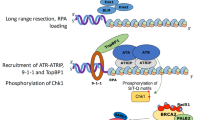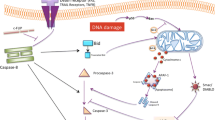Abstract
The human Siva gene is localized to chromosome 14q32-33 and gives rise to the full-length predominant form, Siva-1 and a minor alternate form, Siva-2 that appears to lack the proapoptotic properties of Siva-1. Our recent work has shown that the missing region in Siva-2 encodes a unique twenty amino acid putative amphipathic helical region (SAH, residues 36–55 in Siva-1). Despite the fact that Siva-1 does not belong to the BCL-2 family, it specifically interacts with the anti-apoptotic protein BCL-XL and sensitizes MCF7 breast cancer cells expressing BCL-XL to UV radiation induced apoptosis. Deletion mutagenesis has mapped the necessary region to the SAH in Siva-1. In this paper we demonstrate that the SAH region in Siva-1 is sufficient to specifically interact with the anti-apoptotic members of the BCL2 family such as BCL-XL and BCL-2 but not its apoptotic member BAX. Using transient transfections and direct microinjection of synthetic SAH peptides, we also demonstrate that the SAH region is sufficient to inhibit the BCL-XL mediated cell survival and render MDA-MB-231 and MCF7 breast cancer cells expressing BCL-XL highly susceptible to UV radiation induced apoptosis. The underlying mechanism of action of SAH mediated inhibition of BCL-XL (and/or BCL2) cell survival appears to be due to loss of mitochondrial integrity as reflected in enhanced cytochrome c release leading to the activation of caspase 9 and finally caspase 3.
Similar content being viewed by others
References
Ashkenazi A. Targeting death and decoy receptors of the tumour-necrosis factor superfamily. Nature Reviews Cancer 2002; 2: 420–430.
Cory S, Adams JM. The Bcl2 family: Regulators of the cellular life-or-death switch. Nat Rev Cancer 2002; 2: 647–656.
Nagata S. Apoptotic DNA fragmentation. Exp Cell Res 2000; 256: 12–18.
Opferman JT, Korsmeyer SJ. Apoptosis in the development and maintenance of the immune system. Nat Immunol 2003; 4: 410–415.
Peter ME, Krammer PH. The CD95(APO-1/Fas) DISC and beyond. Cell Death Differ 2003; 10: 26–35.
Rathmell JC, Thompson CB. Pathways of apoptosis in lymphocyte development, homeostasis, and disease. Cell 2002; 109(Suppl): S97–S07.
Strasser A, O'Connor L, Dixit VM. Apoptosis signaling. Annu Rev Biochem 2000; 69: 217–245.
Wallach D, Varfolomeev EE, Malinin NL, Goltsev YV, Kovalenko AV, Boldin MP. Tumor necrosis factor receptor and Fas signaling mechanisms. Annu Rev Immunol 1999; 17: 331–367.
Nagata S, Nagase H, Kawane K, Mukae N, Fukuyama H. Degradation of chromosomal DNA during apoptosis. Cell Death Differ 2003; 10: 108–116.
Amakawa R, Hakem A, Kundig TM, et al. Impaired negative selection ofTcells in Hodgkin's disease antigen CD30-deficient mice. Cell 1996; 84: 551–562.
Majdan M, Lachance C, Gloster A, et al. Transgenic mice expressing the intracellular domain of the p75 neurotrophin receptor undergo neuronal apoptosis. J Neurosci 1997; 17: 6988–6998.
Prasad KV, Ao Z, Yoon Y, et al. CD27, a member of the tumor necrosis factor receptor family, induces apoptosis and binds to Siva, a proapoptotic protein. Proc Natl Acad Sci USA 1997; 94: 6346–6351.
Baker SJ, Reddy EP. Modulation of life and death by the TNF receptor superfamily. Oncogene 1998; 17: 3261–3270.
Kawabe T, Naka T, Yoshida K, et al. The immune responses in CD40-deficient mice: Impaired immunoglobulin class switching and germinal center formation. Immunity 1994; 1: 167–178.
Reed JC, Green DR. Remodeling for demolition: Changes in mitochondrial ultrastructure during apoptosis. Mol Cell 2002; 9: 1–3
Scorrano L, Korsmeyer SJ. Mechanisms of cytochrome c release by proapoptotic BCL-2 family members. Biochem Biophys Res Commun 2003; 304: 437–444.
Li H, Zhu H, Xu CJ, Yuan J. Cleavage of BID by caspase 8 mediates the mitochondrial damage in the Fas pathway of apoptosis. Cell 1998; 94: 491–501.
McDonnell JM, Fushman D, Milliman CL, Korsmeyer SJ, Cowburn D. Solution structure of the proapoptotic molecule BID: A structural basis for apoptotic agonists and antagonists. Cell 1999; 96: 625–634.
Wang K, Yin XM, Chao DT, Milliman CL, Korsmeyer SJ. BID: A novel BH3 domain-only death agonist. Genes Dev 1996; 10: 2859–2869.
Yin XM. Bid, a critical mediator for apoptosis induced by the activation of Fas/TNF-R1 death receptors in hepatocytes. J Mol Med 2000; 78: 203–211.
Cao C, Ren X, Kharbanda S, Koleske A, Prasad KV, Kufe D. The ARG tyrosine kinase interacts with Siva-1 in the apoptotic response to oxidative stress. J Biol Chem 2001; 276: 11465–11468.
Henke A, Launhardt H, Klement K, Stelzner A, Zell R, Munder T. Apoptosis in coxsackievirus B3-caused diseases: Interaction between the capsid protein VP2 and the proapoptotic protein siva. J Virol 2000; 74: 4284–4290.
Henke A, Nestler M, Strunze S, Saluz HP, Hortschansky P, Menzel B, Martin U, Zell R, Stelzner A, Munder T. The apoptotic capability of coxsackievirus B3 is influenced by the efficient interaction between the capsid protein VP2 and the proapoptotic host protein Siva. Virology 2001; 289: 15–22.
Padanilam BJ, Lewington AJ, Hammerman MR. Expression of CD27 and ischemia/reperfusion-induced expression of its ligand Siva in rat kidneys. Kid Int 1998; 54: 1967–1975.
Spinicelli S, Nocentini G, Ronchetti S, Krausz LT, Bianchini R, Riccardi C. GITR interacts with the pro-apoptotic protein Siva and induces apoptosis. Cell Death Differ 2002; 9: 1382–1384.
Yoon Y, Ao Z, Cheng Y, Schlossman SF, Prasad KV. Murine Siva-1 and Siva-2, alternate splice forms of the mouse Siva gene, both bind to CD27 but differentially transduce apoptosis. Oncogene 1999; 18: 7174–7179.
Xiao H, Palhan V, Yang Y, Roeder RG. TIP30 has an intrinsic kinase activity required for up-regulation of a subset of apoptotic genes. EMBO J 2000; 19: 956–963.
Xue L, Chu F, Sun X, Borthakur A, Ramarao M, Pandey P, Wu M, Schlossman SF, Prasad KV. Siva-1 binds to and inhibits BCL-X(L)-mediated protection against UV radiation-induced apoptosis. Proc Natl Acad Sci USA 2002; 99: 6925–6930.
Janicke RU, Sprengart ML, Wati MR, Porter AG. Caspase-3 is required for DNA fragmentation and morphological changes associated with apoptosis. J Biol Chem 1998; 273: 9357–9360.
Janicke RU, Ng P, Sprengart ML, Porter AG. Caspase-3 is required for alpha-fodrin cleavage but dispensable for cleavage of other death substrates in apoptosis. J Biol Chem 1998; 273: 15540–15545.
Hishikawa K, Oemar BS, Tanner FC, Nakaki T, Luscher TF., Fujii T. Connective tissue growth factor induces apoptosis in human breast cancer cell line MCF-7. J Biol Chem 1999; 274: 37461–37466.
Liang Y, Yan C, Schor NF. Apoptosis in the absence of caspase 3. Oncogene 2001; 20: 6570–6578.
Narvaez CJ, Byrne BM, Romu S, Valrance M, Welsh J. Induction of apoptosis by 1,25-dihydroxyvitamin D3 in MCF-7 Vitamin D3-resistant variant can be sensitized by TPA. J. Steroid Biochem. Mol Biol 2003; 84: 199–209.
Simoes-Wust AP, Schurpf T, Hall J, Stahel RA, Zangemeister-Wittke U. Bcl-2/bcl-xL bispecific antisense treatment sensitizes breast carcinoma cells to doxorubicin, paclitaxel and cyclophosphamide. Breast Cancer Res Treat 2002; 76: 157–166.
Sun X, Bratton SB, Butterworth M, MacFarlane M, Cohen GM. Bcl-2 and Bcl-xL inhibit CD95-mediated apoptosis by preventing mitochondrial release of Smac/DIABLO and subsequent inactivation of X-linked inhibitor-of-apoptosis protein. J Biol Chem 2002; 277: 11345–11351.
Stennicke HR, Deveraux QL, HumkeEW, Reed JC, Dixit VM, Salvesen GS. Caspase-9 can be activated without proteolytic processing. J Biol Chem 1999; 274: 8359–8362.
Renatus M, Stennicke HR, Scott FL, Liddington RC, Salvesen GS. Dimer formation drives the activation of the cell death protease caspase 9. Proc Natl Acad Sci USA 2001; 98: 14250–14255.
Srinivasan A, Li F, Wong A, et al. Bcl-xL functions downstream of caspase-8 to inhibit Fas-and tumor necrosis factor receptor 1-induced apoptosis of MCF7 breast carcinoma cells. J Biol Chem 1998; 273: 4523–4529.
Narita M, Shimizu S, Ito T, et al. Bax interacts with the permeability transition pore to induce permeability transition and cytochrome c release in isolated mitochondria. Proc Natl Acad Sci USA 1998; 95: 14681–14686.
Sattler M, Liang H, Nettesheim D, et al. Structure of BclxL-Bak peptide complex: recognition between regulators of apoptosis. Science 1997; 275: 983–986.
Mihara M, Erster S, Zaika A, et al. p53 has a direct apoptogenic role at the mitochondria. Mol Cell 2003; 11: 577–590.
Cheng EH, Levine B, Boise LH, Thompson CB, Hardwick JM. Bax-independent inhibition of apoptosis by Bcl-XL. Nature 1996; 379: 554–556.
Hsu YT, Youle RJ. Nonionic detergents induce dimerization among members of the Bcl-2 family. J Biol Chem 1997; 272: 13829–13834.
Hsu YT, Youle RJ. Bax in murine thymus is a soluble monomeric protein that displays differential detergent-induced conformations. J Biol Chem 1998; 273: 10777–10783.
Rampino N, Yamamoto H, Ionov Y, et al. Somatic frameshift mutations in the BAX gene in colon cancers of the microsatellite mutator phenotype. Science 1997; 275: 967–967.
Yin C, Knudson CM, Korsmeyer SJ, Van Dyke T. Bax suppresses tumorigenesis and stimulates apoptosis in vivo. Nature 1997; 385: 637–640.
Okuno K, Yasutomi M, Nishimura N, et al. Gene expression analysis in colorectal cancer using practical DNA array filter. Dis Colon Rectum 2001; 44: 295–299.
Wang JL, Liu D, Zhang ZJ, et al. Structure-based discovery of an organic compound that binds Bcl-2 protein and induces apoptosis of tumor cells. Proc Natl Acad Sci USA 2000; 97: 7124–7129.
Kingston RE. Introduction of DNA into mammalian cells. In: Ausubel FM, Brent R, Kingston RE, et al. eds. Current Protocols in Molecular Biology. New York: John Wiley & Sons, Inc. 1987: 9.1.4–9.1.11.
Author information
Authors and Affiliations
Corresponding author
Rights and permissions
About this article
Cite this article
Chu, F., Borthakur, A., Sun, X. et al. The Siva-1 putative amphipathic helical region (SAH) is sufficient to bind to BCL-XL and sensitize cells to UV radiation induced apoptosis. Apoptosis 9, 83–95 (2004). https://doi.org/10.1023/B:APPT.0000012125.01799.4c
Issue Date:
DOI: https://doi.org/10.1023/B:APPT.0000012125.01799.4c




